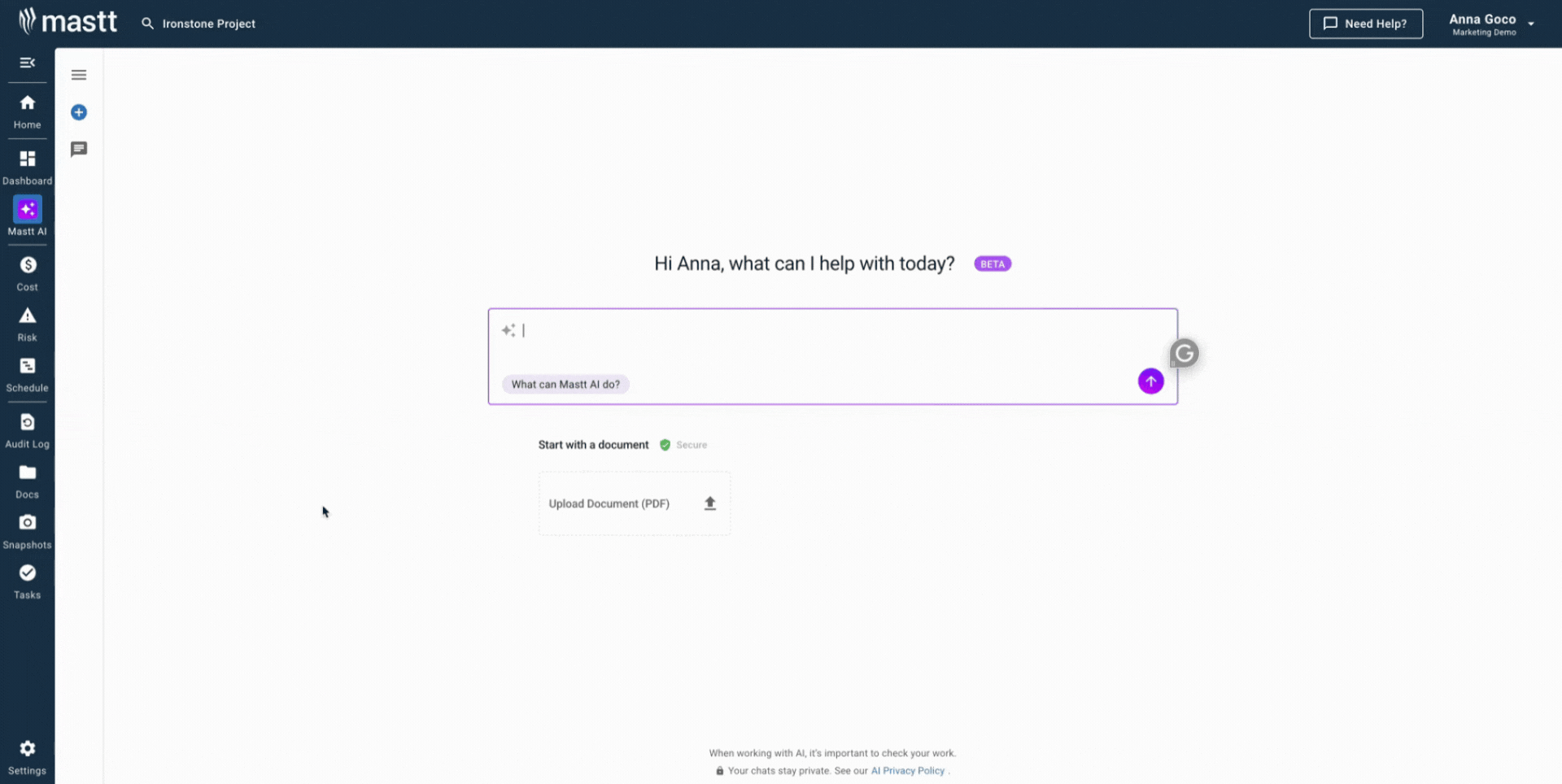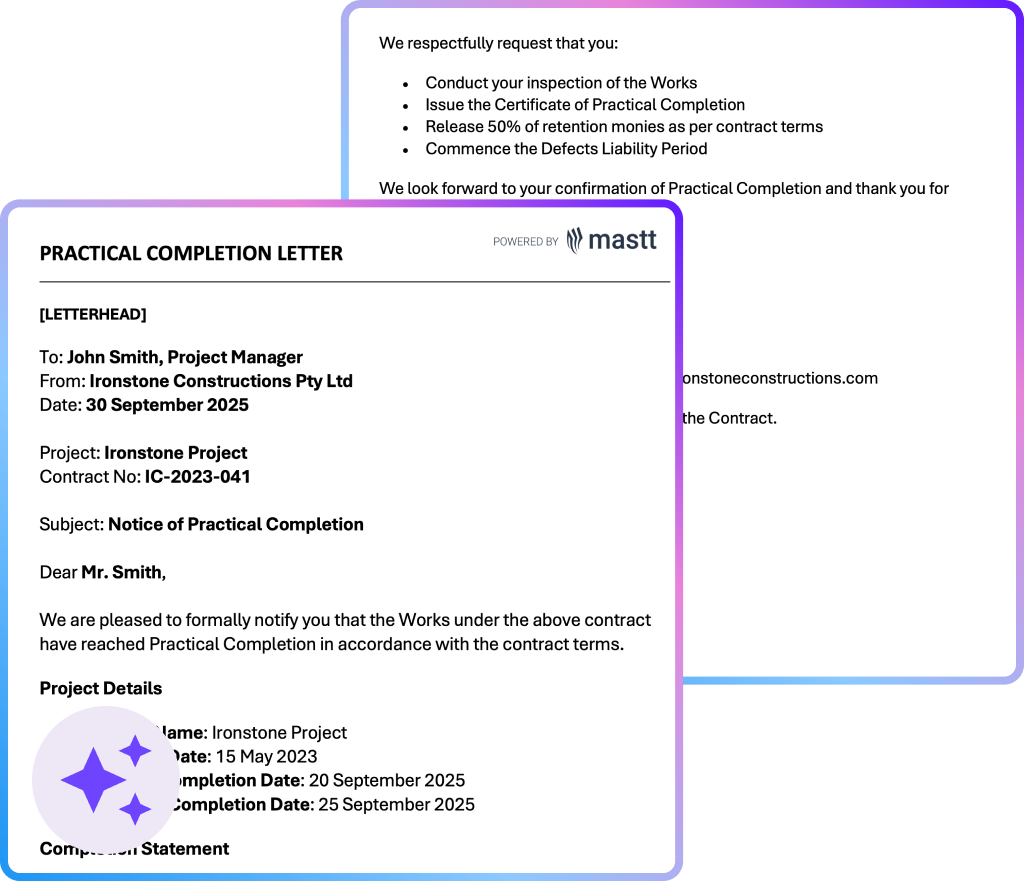What is a Practical Completion Letter?
A practical completion letter is a formal document issued by a contractor to confirm that a construction project has reached practical completion. It acknowledges that all contractual work has been completed, apart from minor defects that do not prevent the project from being used for its intended purpose.
The practical completion letter serves as an official request for a Practical Completion Certificate and marks the start of the defects liability period. Using a notice of practical completion template ensures consistency, clear communication with stakeholders, and compliance with contract requirements.
What’s Included in a Practical Completion Letter for Construction
A practical completion letter includes the key details needed to confirm that a construction project has reached practical completion. It provides a structured record of completion, minor outstanding works, and the formal handover to the project owner.
Typical inclusions in a notice of practice completion are:
- Project information: Contract number, project title, and site address.
- Practical completion date: The agreed date at which the project is deemed practically complete.
- Defects schedule: A list of minor defects or incomplete works to be addressed during the defects liability period.
- Certification statement: Confirmation by the superintendent, contract administrator, or project manager that the project meets the criteria for practical completion.
- Handover details: Information about keys, manuals, warranties, and access for the owner.
- Retention and payments: Notes on release of retention money or entitlement to final payment under the contract.
- Signatures and authorisation: Signed confirmation from the construction superintendent, project owner, or other responsible authority.
💡 Pro Tip: Always cross-reference the letter with the contract’s definition of practical completion to avoid disputes later in the project.
Why Use a Template for Practical Completion Letters
Using a practical completion letter template ensures consistency, compliance, and efficiency at project handover. It gives project teams a ready-to-go format that covers all necessary details without missing critical information.
Key reasons to use a template include:
- Accuracy: Ensures all required contract information is included, reducing the chance of errors.
- Time savings: Eliminates the need to draft from scratch, speeding up the closeout process.
- Consistency: Standardises the way practical completion is documented across projects.
- Compliance: Helps meet contractual and legal requirements for completion notices.
- Transparency: Provides a clear, uniform document that reduces misunderstandings between owners, contractors, and consultants.
- Record-keeping: Creates a professional document that can be easily logged in a submittal log template for audit and future reference.
Save your template as a master copy and adapt it for each project, so you always start with a compliant foundation.
Who Should Use a Practical Completion Letter for Construction Projects
A practical completion letter should be used by anyone responsible for certifying, managing, or acknowledging the completion of construction works. It ensures each party involved in the project closeout has a clear and consistent record of completion.
Key users of a notice of practical completion include:
✅ Project Owners and Developers: Formally accept practical completion, trigger warranties, and prepare for building occupation.
✅ Project Managers: Certify that works meet contractual requirements and oversee the transition into the defects liability period.
✅ Contract Administrators and Superintendents: Issue the official letter, confirm compliance, and document completion details.
✅ Contractors: Request acknowledgment of practical completion and secure entitlement to final claims or retention release.
✅ Legal and Compliance Teams: Maintain a record of handover for audits, disputes, or regulatory checks.
💡 Pro Tip: Always circulate the signed letter to all relevant parties, not just the contractor, so that warranties, insurances, and defect obligations are triggered without delay.
How to Use a Construction Practical Completion Letter
To use a practical completion letter, fill in the project and contract details, confirm compliance with practical completion requirements, and attach any defects schedule. Once certified, the letter should be signed, issued to all stakeholders, and stored in the project records.
To use a practical completion letter effectively:
- Enter project details: Include contract number, project name, and site address.
- Confirm compliance: Ensure the works meet the contract definition of practical completion.
- List minor defects: Attach a schedule of works to be completed during the defects liability period.
- Certify completion: Have the superintendent, contract administrator, or project manager sign the letter.
- Distribute copies: Send the letter to contractors, owners, and consultants.
- Record for compliance: Log the practical completion letter in the submittal log template or project file.
Keep a digital copy of every practical completion letter alongside certificates, warranties, and approvals so the full project closeout trail is easy to access.
Generate Practical Completion Letters in Seconds with Mastt AI
Mastt AI makes it simple to generate a practical completion letter tailored to your project’s contract requirements. Instead of formatting from scratch, Mastt AI creates a structured, professional document that confirms handover, defects liability, and completion dates in minutes.
Here’s what you can do with Mastt AI right away:
🚀 Create practical completion letters instantly: Generate a clear and compliant notice with all required project details, signatures, and certification statements.
📂 Customise to match your contract: Adjust wording, defects schedules, and retention notes so the letter reflects your project-specific requirements.
📑 Export in the format you need: Download your practical completion letter in Word, Excel, or PDF for easy distribution and record-keeping.
Mastt AI applies industry-standard construction knowledge to recommend the right structure, helping you avoid omissions and disputes during project closeout.
Here’s how to get started with Mastt AI:
- Describe your need: Type a request such as “create a practical completion letter” into the chat.
- Customise with AI: Adjust details like completion dates, defect lists, or signatories directly in your secure workspace.
- Export your template: Download the final letter in the format required for contract submission and project records.
With Mastt AI, every practical completion letter is created securely, and your conversations are never used to train the system. You stay in full control of how documents are customised, saved, and shared.
👉 Explore more tips in our Help Center and start creating professional practical completion letters with Mastt AI today.

When to Use a Notice of Practical Completion Template
A practical completion letter template should be used when construction works are complete and the project can be occupied or used as intended, with only minor defects remaining. The letter serves as the formal trigger for the handover process, marking the start of the defects liability period and determining eligibility for final payment or retention release.
Key situations where a practical completion letter is required include:
- At project handover: When the superintendent or contract administrator determines the works meet the conditions for practical completion.
- Before occupancy: When owners need confirmation that the building can be safely occupied or put into operation.
- Commencing the defects liability period: To officially document the start date for defect rectification obligations.
- Contractual entitlements: To enable contractors to lodge their final payment claims or request the release of retention funds.
- Record-keeping and compliance: To provide evidence of completion in the project’s submittal log template and support future audits or legal requirements.
💡 Pro Tip: Always issue the practical completion letter promptly, as delays can affect insurance coverage, warranties, and the release of contractor entitlements.
Common Problems with Static Practical Completion Letter Templates
Practical completion letters are often managed manually in Word, Docs, or static PDFs, which can create gaps in accuracy and compliance. Without a consistent process, project teams risk miscommunication, delays, and disputes during the critical handover stage.
Typical problems include:
⚠️ Incomplete details: Missing project data, contract references, or signatures that make the letter invalid.
⚠️ Date disputes: Contractors and owners disagree on the exact date of practical completion due to inconsistent wording.
⚠️ Unclear defects list: Defects documented poorly or not attached at all, leading to confusion during the liability period.
⚠️ Formatting issues: Letters drafted in Word or Docs often lack a standard structure, while scanned PDFs are harder to edit or update.
⚠️ Poor record-keeping: Failure to log the issued letter in a submittal log template, making audits and compliance checks difficult.
💡 Pro Tip: Instead of relying solely on PDFs or Word files, use a structured practical completion letter template that can be updated, shared, and stored digitally for a consistent closeout record across every project.
Turn Practical Completion into a Smooth Handover with Mastt AI
Issuing a practical completion letter shouldn’t slow down project closeout. Mastt AI creates a professional, contract-ready letter in just a few clicks, removing the need to build and format documents in Word, Docs, or PDF.
From small builds to large-scale developments, Mastt AI delivers practical completion letters tailored to your project scope and contract terms. Every document is generated in a secure workspace, giving you confidence that sensitive project information stays private.
👉 Generate your practical completion letter with Mastt AI today and hand over projects with speed, accuracy, and compliance.









